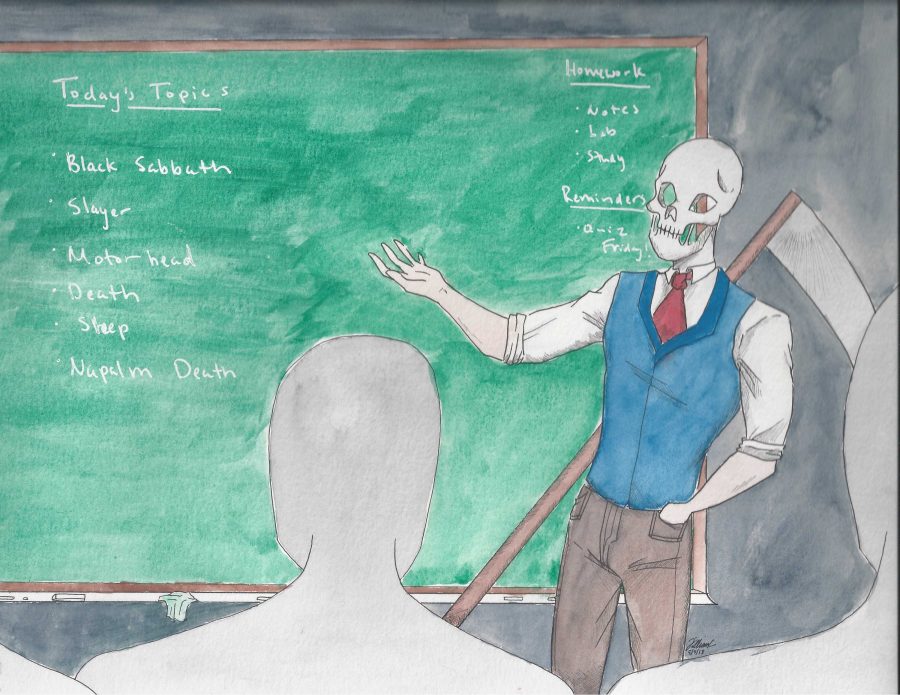Metal is an exclusive genre. Given today’s trends of popular music, it may feel even impossible to break into such an isolated genre. It’s hard to tell what’s good and what’s not so good because, well, to us regular people, it all sounds too similar to distinguish. I’m here to guide you through each and every genre of metal as they stand out and give you an unbiased opinion as someone who listens to literally anything other than metal. Before we begin, I’d like to make some preliminary notes:
1. Talk about metal at your own discretion. Anyone who religiously listens to metal is likely wildly aggressive and will ream you for liking The Cure or AC/DC. This toxic hierarchy is probably the worst part of the genre. Enjoy what you want to, first and foremost, and approach other fans with extreme caution.
2. Forget what you know. Yeah, sure, enjoy what you want, but you also have to remember that metal is an extreme subculture. Artists will build off artists who are built off artists; the criteria for enjoying much of this music is largely contained within itself, which is largely the reason why it is so elitist. Think of it this way: you are not here to analyze, only to thrash.
3. You may as well just stop now. Just straight up don’t read this article. If what I’ve already said hasn’t given you a good idea that metal is culturally an acid bath (get it?), then maybe just dip your toes in. Listen to one song from Car Bomb and decide if this is truly the life you want to live (and let me know, I like new friends). Maybe you’re a masochist who’s bent on eclecticism and you really, truly, sincerely want a proper introduction to the genre. Or you just wanna learn some black magic. Either way, I’m here for you.
Metal came out of a conglomerate history of many different genres. The wild instrumentation of jazz and a focus on its unique progressions in blues had artists like Cream and Jimi Hendrix pioneering a more esoteric sound. The raw aggressiveness of early garage rock also contributed heavily, leading to the rise of heavy rock stars such as Led Zeppelin and Budgie.
Budgie is an excellent example when observing the pieces that make up the origins of metal. Their debut album is a clean split between a sharp rock chorus with banshee vocals, and an acoustic base for melodramatic lyrics. They also pushed the boundaries literally with tracks like “Nude Disintegrating Parachutist Woman” and “Homicidal Suicidal.” Although Budgie stamps out the foundations, Black Sabbath developed alongside them to piece together an entirely new structure: heavy metal.
The band had previously gone through multiple changes, under the names Mythology and Earth. After finding out that they were being mistaken for another British band by the name of Earth, they looked for yet another change. Across the street from their studio was a theater playing the movie “Black Sabbath;” bassist Geezer Butler wondered why so many people would pay money to be scared and uncomfortable. With that in mind, he and Ozzy Osbourne began writing the song that would shoot their career into the next level. Partly what makes Black Sabbath’s debut so influential is the use of the tritone—termed “the devil’s interval” from an early age—to make their sound holistically sinister. In the late 70’s, however, Ozzy Osbourne was fired from the band, and the movement lost its headsman.
Political and economic unrest in Great Britain at the same time had led to a grand punk movement— it was a massive wildfire of rebellion and escapism into the heavy metal superstars of the decade. While they did not catch the speeding current of the New Wave Of British Heavy Metal (NWOBHM), Motörhead’s presence was revitalizing. They were among the first to compress heavy metal and punk rock with skill and overwhelming force. Lead singer Lemmy Kilmister’s vision was to create something vicious and fast; in hindsight, this quality can be overlooked. This was truly a fundamental fusion of punk and metal, what would be a catalyst for many future groups and sprawling deviations. Motorhead put the NWOBHM into fifth gear, pushing bands like Iron Maiden, Diamond Head, Holocaust, and several others into the spotlight.
Out of NWOBHM’s influence comes several different utilizations of the punk influence, many of which I can’t even name within the span of this article. Speed metal and thrash are oftentimes described interchangeably. What makes it difficult to distinguish is that speed went straight into thrash like a flowing river. Speed took those fast aggressive styles, but was usually more melodic and less harsh in individual elements like instrumentation and vocals. Thrash has many similarities, but also diversified and established itself as a unique category rather than a pit stop-like speed. Many bands took the punk aspect in an anticultural sense, which placed heavy pressure and criticism on the more popular glam metal. To determine differences, we can compare two major forces within each category: Exciter and Sepultura.
Despite the album being released in 2004, it contains many earlier tracks which convey their sounds fairly cohesively. There is a clear usage of power chords, plenty of banshee and rare instances of growl. Most notable is a frequent manipulation of tempo and ritardando, which accents the fast pace as something unique in its time. “Blackwitch” is really the only song that does not follow the formulaic principles laid out in the rest of the album, with sequenced acoustic guitar compiling into dissonant chords, and then a characteristically slower section to fill it out and keep it defined as “metal.”
Now looking at the debut album for Sepultura, “Morbid Visions” still employs a raging fast percussion and a swift intensity, but Sepultura prefers to make their guitars shriek rather than their vocals. Reverberated grunts can summarize most of the vocals in the album. The almost comical intermission “The Curse” features such a low grunt that it may very well be coming from an actual demon. Differences in lyrical themes are probably what make them most distinctive; where Exciter uses more generally brutal imagery, Sepultura holds an abundance of sacrilegious titles. The devil-worshipping themes are also frequent with Slayer, Metallica, Death, and other influential bands. Why I chose to focus on Sepultura rather than these bands is because the progressiveness of the genre really shines in their later albums such as “Roots” and “Against,” as well as their duality for being described primarily as groove metal, which uses thrash techniques at a slower tempo.
Speaking of influence, Slayer’s “Reign in Blood” cannot be understated in death metal’s legacy. Slayer had gotten tired of the repetitive riffs of its rivals, and aimed for something more concise and intentional. It is an amount of structure and production that had yet to be seen in the genre, much less the band itself. Its lyrical themes were so extreme that Columbia Records initially refused to distribute due to “Angel of Death’s” lyrics, as they pertain to the Holocaust and Josef Mengele. It was here that death metal took to its wild spree.
Although the genre is widely considered to be founded by “Reign in Blood,” Possessed has also cited Venom, Motorhead, and the early works of Exodus as the groundwork for their own sound. The drummer, Mike Sus, now employs what are termed as “blast beats,” which focus less on the tempo and more on inciting chaos. Sus has trouble keeping up with himself in some instances. In addition to tempo, key and signature jumps wildly and uses of atonality and chromatic progressions are abundant. Disregard what I said about “The Curse;” the intro to “Pentagram” is so inhuman that I would cite Mike Torrao as your go-to man for summoning spells. We close with “Death Metal,” which is only the frenetic end of the beginning. Death metal would prosper in the late 1980’s after Possessed had abruptly thrown the torch across the stadium; Death, Autopsy, Morbid Angel, Bolt Thrower and Obituary had all received critical acclaim.
For many groups which were later described as doom metal, they would find themselves at the very underground of the genre. Building off Black Sabbath’s early discographies, doom aimed for that dreadful, ominous, doom-ridden sound with booming low bass and powerful effects. There was a neglect for the grunts and shrieks found on other ends of the spectrum, although it was scantly incorporated in certain works. Lyrics would focus less on satanic endeavors and more on a general sense of dread.
Pentagram had a hectic 12 years between its formation and its self-titled studio debut in 1985, later titled “Relentless.” Due to its early conception of the genre, the wall of sound had yet to be built to its full potential. Nevertheless, Bobby Liebling’s vocals are entirely more manageable, and as a whole, the album feels less like it’s trying to attack the listener and more like it’s trying to have a slightly-uncomfortable-yet-still-engaging conversation.
Let’s take a look at another cornerstone with a much more distinct sound. Candlemass’ “Nightfall” approaches as a tsunami of sound in the dark with “Gothic Stone.” Tempo is molasses comparatively, and the long chords allow the listener to digest every sonic inch of despair. They allow something more melancholic and epic in “Gallows End,” with an acoustic backup, simple progressions and mid-range vibrato. “Only the vultures will come to see me hung;” although Candlemass fell out of status quite quickly with a lack of ingenuity, their second album is the absolute pinnacle of doom.
This new subgenre built on the more creepy and psychedelic works of Black Sabbath, as well as other acts like The Doors, Beefheart, and Swans. Sludge metal is a category that flaunts these aspects strongly; there are experimental, noise rock, southern rock and probably many other influences. The genre’s eclectic origin definitively came out of Melvins.
This compilation album contains an archive of unique metal workings, easily digestible due to the short length of most tracks. “Oven” features a silent drop, which many other groups seem to be scared to do even though it’s so awesome. “Revulsion/We Reach” uses stuttering chords simultaneously pitching down to create a true feeling of depth, followed by slow, deep bass to signify the bottom. “Eye Flys” uses a 3 over 4 polyrhythm along with noise-ridden electric guitar droning over. To talk about everything in this mega-LP would probably take an entire tab, so I’ll save you the trouble.
Now, with the smoother base of doom and sludge, “stoner metal” was free to stretch its legs. The genre has also been called “stoner rock” or “desert rock,” but some consider these to be separate categories. People also seem to be confused about the influences of the genre; some set the origin at Black Sabbath’s “Master of Reality,” and others reject the heavy metal roots altogether. Rather than determining what made stoner metal, I think it’s better to focus on what it is.
While Sleep’s “Volume One” is a sludge masterpiece, the distinction really comes out in their second LP. They create their wall of sound in more interesting ways and aren’t afraid to pull apart some of that wall and get really, really wet with their bass. The intro track “Dragonaut” shows all of this well; tempo shifts and breakdowns are also used extensively to always keep you interested in its riffs. Then comes the intermission song of “Some Grass,” a short acoustic rockabilly solo that melts any doubt that you had about the term “stoner metal.”
In the late 1980’s emerged Napalm Death, then classified as a crust punk band who began to take on multiple other aspects into their sound, most notable being the introduction of drummer Mick Harris, who was credited with the genre’s name. Grindcore mixed hardcore punk, extreme metal-like death and noise rock to create what could be described as the thrasher version of sludge metal. Blast beats of 200 bpm or higher which put the listener in a state of pure entropy. With experimental instrumentation like high gain or downtuning, grindcore is truly for the hardcore audience. Brevity was also central; Napalm Death had owned the 2001 Guinness world record for “shortest music video”—1.3 seconds.
Speaking of a hardcore audience, we have finally reached the end of the road. Black metal is a euphemism for “satanic metal,” a nest for the least accessible fringes. Vehemently anti-Christian, misanthropic and occasionally neo-Nazi, black metal is intentionally difficult, primal and contradictory in its unification of extreme individuals. The genre originated in the works of Bathory and Venom, described as the “first wave” of black metal.
Intense, serrated guitars play over each other to create a harsh ghost note deep in your soul. Vocals are sometimes out of sync and unintelligible over the banshee guitars. The album cover is a satan-goat-man emerging from the darkness to tell you his secrets. If I had one word to describe this music, it would be “hell.”
Now, what distinguishes the first wave apart from the second is largely commitment to the act. Several bands in Norway activated a scene which took heavy influence from Bathory and other first wave artists, as well as adding other commonalities such as Monikers, corpse paint and a hardcore anti-cultural ethos that they claimed to be entirely authentic. Some artists were put in prison for acts of murder and church burnings. They had built a wall around themselves and denied all who weren’t fully committed to their primitive ideals.
Darkthrone became a spearhead for Norwegian black by sticking consistently to the sound that they initially established: raw and uncompromising. Originally considered a death metal band, they had cited Bathory and Slayer among their influences—they were almost destined to put the movement in motion. Similarities can easily be drawn with Bathory on their first three albums, which were considered the height of their career.







